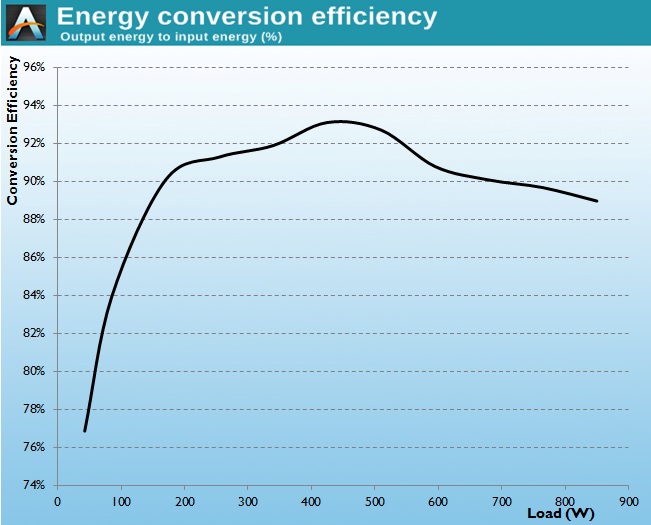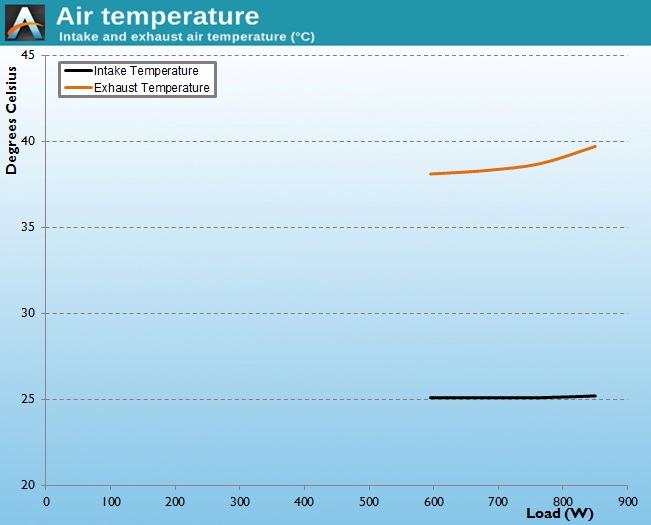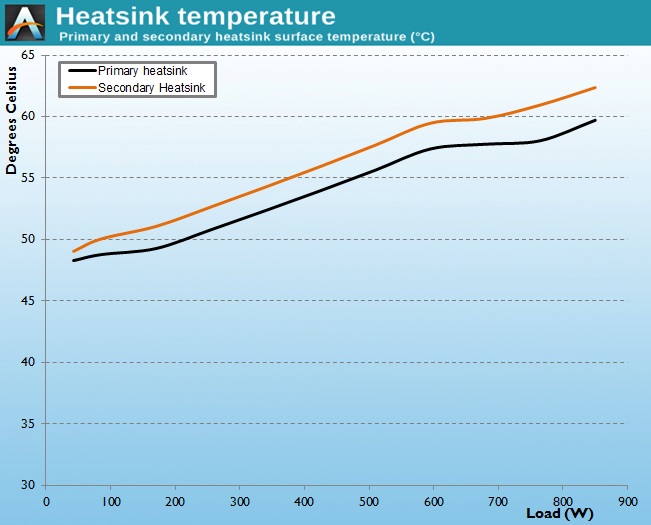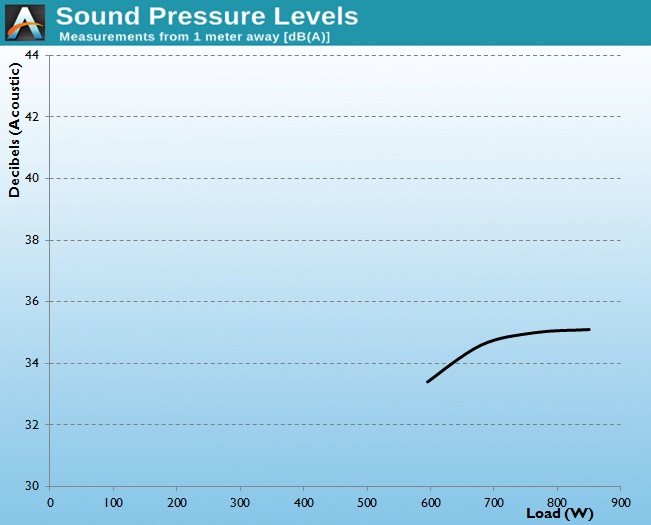EVGA Supernova 850 G2 Power Supply Review
by E. Fylladitakis on May 30, 2014 6:00 AM EST- Posted in
- Cases/Cooling/PSUs
- PSUs
- EVGA
- Super Flower
Cold Test Results
For the testing of PSUs, we are using high precision electronic loads with a maximum power draw of 2700 Watts, a Rigol DS5042M 40 MHz oscilloscope, an Extech 380803 power analyzer, two high precision UNI-T UT-325 digital thermometers, an Extech HD600 SPL meter, a self-designed hotbox and various other bits and parts. For a thorough explanation of our testing methodology and more details on our equipment, please refer to our How We Test PSUs - 2014 Pipeline post.
The performance of the Supernova 850 G2 at room temperature displays why Superflower's Leadex platform became so popular among enthusiasts. With an average energy conversion efficiency within the nominal load range (20% to 100%) of 91.0% and a maximum efficiency of 93.1%, the EVGA Supernova 850 G2 honors its 80 Plus Gold certification without issues. Loads lower than 170 Watts will make the efficiency of the Supernova 850 G2 plummet, dropping down to 76.9% with a load of 43 Watts, which however is natural for most switching PSUs and does not affect the 80 Plus certification, which takes into account only the 20% to 100% nominal capacity range.
The most surprising outcome of our cold testing is the thermal behavior of the PSU. Instead of hectically working to keep the temperature of the unit low, the fan will only kick in when it is really needed; therefore, with a highly efficient power supply such as this working in room temperature, the fan did not even start until the load was over 550 Watts. This sort of thermal control however allows the PSU to reach higher temperatures than units of similar specifications, with the temperature of the primary and secondary side heatsinks reaching up to 59.7 °C and 61.8 °C respectively.















22 Comments
View All Comments
Galatian - Friday, May 30, 2014 - link
Why so snark? At last try some constructive criticism.To the Author: a ATX power supply jumper is useful for example when you set up your water cooling loop and you need to bleed in first and to check if there are any leaks. Therefore you don't want the entire system to be powered on obviously.
JarredWalton - Friday, May 30, 2014 - link
Speaking as someone that has done plenty of time with Bitcoin and other cryptocurrencies -- and as the person that added that comment -- I can assure you that using it with BTC ASICs is indeed a plausible scenario, though perhaps becoming less so as everything moves to higher performance ASICs with built-in PSUs.patrickjchase - Friday, May 30, 2014 - link
An ATX P/S jumper is also useful if you want to power a storage enclosure.I use an 850W P/S in a Norco 4224 (4U rackmount case with 24 3.5" hot-swap bays) with an SAS expander in place of the motherboard.
Tunnah - Friday, May 30, 2014 - link
To the author of this comment: you do realise you sound like a complete and utter tool ? If you have something to add, add it, no need to be such a snarky git.bsim500 - Friday, May 30, 2014 - link
"EVGA 850w review, Corsair 1500w review, Corsair 1000w review, LEPA 1700w PSU coming soon", etc.All very nice, but for a change, given the increasing popularity of Mini-ITX, how about a low-end PSU series test of 60-360w PSU's for non-gamers/light gamers/HTPC/office box/net box, etc, that comprise the vast majority of general usage scenario's? I mean 60-160w pico-PSU plus maybe the Seasonic G360 (lowest wattage Gold rated full ATX)?
Removing the discrete GFX card from my main i5-3570 rig, it maxes out at all of 90w (exc monitor) 4T Prime load at 4GHz and idle's at a lowly 24w. An i3-based HTPC / office box typically draws 24-70w. Add a 7790 XBOne equivalent card, and it still barely pulls 120w max when gaming. Yet you wouldn't believe how many tech sites continue to test such usage scenarios with 800-1500w PSU's with low-watt efficiencies that are way down at 50-70%, which results in completely useless figures for the typical uses such machines are built for...
marc1000 - Friday, May 30, 2014 - link
I believe they already did one small-psu test over here, but I'm not able to find it now. google it around a bit.And I agree such big PSUs are not the best option currently. Of course for high-end gaming/computing it does make sense, but with midrange getting better and better each generation, we will soon have a hard time buying such power-hungry computers.
I myself use an i5+gtx660 and run a lot of games. Most of the time I'm limited by v-sync, and not the hardware. I'm not a professional, just play for fun, so no reason to upgrade. My system is powered by a simple 350w unit from Akasa - I'm living on the edge here, but it works: no bluescreens nor shutdowns nor performance hit.
DanNeely - Friday, May 30, 2014 - link
I'd like to see more small/mainstream PSU reviews too. The problem is that most hardware reviewed is whatever the OEMs are willing to provide; meaning there's a large bias towards halo devices over everything else.Death666Angel - Sunday, June 1, 2014 - link
Depends on wether or not people are interested in 120Hz gaming @ 1440p or even 60Hz @ 2160p. For that kind of stuff you need SLI/CF unless you - more or less drastically - reduce IQ.E.Fyll - Sunday, June 1, 2014 - link
True; most of our upcoming reviews will be of high output units. As mentioned, we are limited to what companies like to provide for testing and, for various reasons, every PR department likes to promote the best they have, even though it does not account for the majority of their revenue. This applies to virtually everything, from sewing needles to cars, not just PSUs. However, I have requested low output units from several manufacturers and some of them were positive, therefore we should be posting such reviews in the following months as well.teyink - Saturday, May 31, 2014 - link
Picked this up for $109.99 after rebate today.